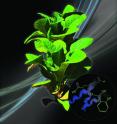Researchers unravel role of priming in plant immunity
Related images
(click to enlarge)
Scientists have discovered a naturally occurring compound that triggers a plant's immune system, thereby protecting the plant from a secondary bacterial infection. The patent-pending discovery could lead to an effective, inexpensive and environmentally safe way to improve plants' resistance to disease, according to research to be published in Science on April 3, 2009.
"The potential for crop protection for organic and conventional farming is strong," said Jean Greenberg, associate professor of molecular genetics and cell biology at the University of Chicago and corresponding author of the study. "This could lead to better food quality and higher agricultural yields.
"We're very excited to see something so practical come out of our lab that could have an impact in the real world," she added.
Although it has long been known that plants have immune systems, just how these systems function has been the subject of intense study. Greenberg and colleagues determined crucial steps and identified new compounds involved in the immune system of Arabidopsis, a plant in the same family as mustard, cabbage, broccoli and cauliflower.
When the pathogen Pseudomonas syringae attacks Arabidopsis, the plant greatly increases its production of azelaic acid, which is then transported via the plant's vascular system to other parts of the plant. The azelaic acid does not directly induce major defenses, but confers on plants the ability to mount a faster and stronger defense response if and when the plant is attacked again.
It does this by increasing the production of salicylic acid, which is known to stimulate microbial resistance in some plants. The researchers also found that azelaic acid stimulates the production of AZ11, a protein that the researchers discovered. AZ11 helps prime the plant to build up its immunity by generating additional salicylic acid.
Azelaic acid's role as a signal in plant immunity represents a significant discovery because it is inexpensive and a natural compound already found in Arabidopsis and many other plants, the researchers said. Furthermore, it is considered safe since it has already been tested in humans. It is used in anti-microbial creams, for hair loss and to treat rosacea.
And since azelaic acid only primes a plant's immune system, the researchers predict that its use will not create a burden on the plant or otherwise detract from the plant's health or productivity. Therefore, plants treated with azelaic acid would not have to invest a lot of energy in their defense until they need to do so.
"Priming is an area of intense interest to many biologists," Greenberg explained. "It is involved in the human immune response and likely plays a role in many responses to environmental changes."
The azelaic acid would be applied to plants by spraying. "This is an attractive way to enhance crop protection because it's natural and doesn't involve genetic modifications," Greenberg said. "Arabidopsis is often used as a model organism for studying higher plants, and we determined that azelaic acid is effective with other families of plants, as well."
Azelaic acid has a lot of potential in agriculture because it is "green," safer than chemicals, and found in many plants, including wheat, rye and barley, according to Wade Williams, Project Manager at the Office of Technology and Intellectual Property at the University of Chicago. "We have found some interest in this idea from agricultural companies, but not much now due to the difficult economy," he said. "We hope that publication in such a prominent, peer-reviewed journal as Science will generate renewed interest."
The other authors of the Science paper, titled "Priming in Systemic Plant Immunity," played critical roles in the research, Greenberg said. Ho Won Jung, the lead author and a post-doctoral scholar in molecular genetics and cell biology at the University of Chicago, optimized a method of extracting active exudates, or plant sap. Collaborator Timothy Tschaplinski of the Department of Energy's Oak Ridge National Laboratory then analyzed plant metabolites in the sap.
It was Tschaplinski who kept noticing a persistent mass spectral signature that occurred in plant sap soon after Arabidopsis plants were exposed to a bacterial pathogen. He realized that the signal matched the pattern of azelaic acid in a database of mass spectral signatures for Arabidopsis metabolites. This led to further investigation by Jung of the biological roles of azelaic acid and AZI1 in plant immunity.
Professor Jane Glazebrook and her graduate student Lin Wang at the Department of Plant Biology at the University of Minnesota contributed to the work by testing the levels of gene expression in response to azelaic acid.
Plant metabolites in sap are a rich source of potentially important molecules in the field of biology, Tschaplinski said. "A number of other novel signatures are clearly evident and could be pursued as a component of the plant-microbe scientific focus area, if that is a route we decide to take."
Source: University of Chicago Medical Center
Articles on the same topic
- Researchers discover primer to plant defense systemFri, 3 Apr 2009, 19:09:34 UTC
Other sources
- Disease-resistant plants are study's focusfrom UPIMon, 6 Apr 2009, 21:58:30 UTC
- Researchers discover primer to plant defense systemfrom Science BlogSun, 5 Apr 2009, 22:42:39 UTC
- Researchers discover primer to plant defense systemfrom Biology News NetSun, 5 Apr 2009, 2:49:11 UTC
- Researchers Discover Primer to Plant Defense Systemfrom Newswise - ScinewsFri, 3 Apr 2009, 19:42:11 UTC
- Researchers discover primer to plant defense systemfrom Science BlogFri, 3 Apr 2009, 19:35:05 UTC
- Researchers unravel role of priming in plant immunityfrom PhysorgThu, 2 Apr 2009, 18:35:48 UTC

